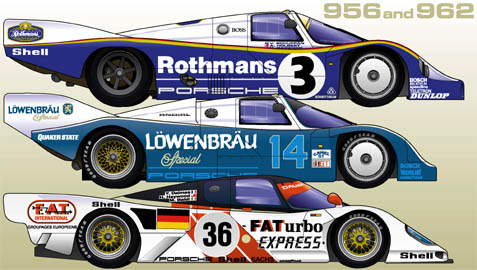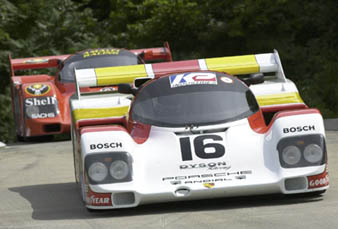Back to Articles

From Speedvision...A Porsche Heritage Story about a Singer creation |
||
| Prototypes for Success
The Immortal Porsche 956 and 962 by Andrew Crask |
||
| Prototypes for Success: The Porsche 956 and 962
Porsches have claimed some 23,000 victories race victories since 1948,
when Ferdinand Porsche’s nephew, Herbert Kaes, drove the very first Porsche
chassis to a class victory in the first auto race held in Austria after
World War II. By far the most successful car manufacturer in international
motorsport, Porsches have been winning throughout racing’s modern era.
Among the more dramatic eras of Porsche dominance took place during the
1980s, when the amazing 956 and 962 models conquered prototype sports car
racing on both sides of the
The genesis of the concept was the introduction of the Group C category for the 1982 World Endurance Championship, which was instituted to expand manufacturer interest in the series. Group C rules removed restrictions on engine capacity, but limited fuel consumption to 600 liters for the 1,000-kilometer races that made up the bulk of the schedule, and 2,600 liters for the 24 Hours of Le Mans. Porsche’s response to the new rules was an all-new aluminum monocoque chassis that utilized ground effects through the use of venturi tunnels under the car. Power was provided by a 2.65-liter twin-turbo flat-six engine generating 620hp. With backing from the Rothmans tobacco company, Porsche’s works team won five race in its first season. This included a decisive triumph at Le Mans, where Jacky Ickx and Derek Bell led all the way from pole position, and bettered the winning miles-completed total of the previous year’s winning Porsche 936 by a staggering 46 miles! For 1983, Porsche built a full dozen 956s for sale to private teams—although the works team still had an ace up its sleeve in the form of a new Motronic engine management system that upped output to 640hp and improved fuel consumption. The results spoke for themselves as 956s swept the top eight places at Le Mans in 1983 (with (Vern Schuppan, Al Holbert and Hurley Haywood leading a 1-2 sweep for the works team), while Ickx repeated as the WEC driving champion. Although the works team sat out Le Mans in ’84 over a dispute with the rule makers, Joest Racing won the French classic for Porsche anyway with a customer 956. With the Group C program in good hands, Porsche looked to bring the 956 to America and the IMSA Camel GTP Series. IMSA differed from WEC, however, in having rules based on an engine equivalency formula rather than fuel consumption limitations. IMSA also specified that the driver’s foot pedal box be behind the front wheel centerline, for safety reasons. The resulting IMSA-spec version, designated 962, incorporated a 2.4-inch extension to the wheelbase to accommodate the footbox regulation along with slightly differing bodywork to accommodate IMSA requirements, which resembled the "longtail" aerodynamics developed for the 956 at Le Mans. The 962 premiered at the Daytona 24-hour in 1984, and appeared set for victory before mechanical teething problems intervened. The independent teams that made up the bulk of the IMSA series immediately recognized the possibilities represented by the car, and a long line of customers beat a path to Porsche’s door. One of the strongest customer teams was Al Holbert’s Löwenbräu-backed effort, which won three consecutive Camel GT titles from 1985-’87. All told, the 962 would capture no fewer than 54 Camel GT race wins. European rule makers ultimately copied their IMSA regarding the driver’s
footbox, so Porsche adapted the 962 back to Group C. For 1985, the works
team replaced its 956s with 962C models that were powered by water-cooled
three-liter versions of the familiar flat-six turbo. Despite increasing
competition from the likes of the factory-backed Jaguar team from Tom Walkinshaw
Racing, the Rothmans Porsches secured Le Mans titles in 1985 and ’86 with
The advancing age of the 956/962 design seemed finally to have caught up with it when Jaguar’s factory team finally supplanted Porsche as World Endurance Champion in 1987 (although Bell and Holbert teamed up to win Le Mans yet again that year), and the works team withdrew. However, customer cars remained the backbone of the series for several more years, and were still winning IMSA races as late as 1993, the final year of the GTP formula. There would be no quiet retirement for the 962, however. For 1994, Porsche joined with specialty car builder Dauer Racing to prepare a GT-category version of the 962 for Le Mans, adapted from a limited-production road car built by Dauer. Although seemingly overmatched by the much more powerful Group C Toyotas, the more fuel-efficient Dauer Porsches made up time on their Japanese rivals by making fewer pit stops, and they also proved more reliable. At the end of the 24 hours, Yannick Dalmas, Mauro Baldi and Hurley Haywood stood atop the podium to celebrate a seventh victory for the 956/962 at sports car racing’s most celebrated event. It was a worthy sendoff for one of the greatest designs in the history of sports car racing. |
Porsche's
ground-effects 956 (TOP) gave rise to the 962 GTP version (MIDDLE) and
then came full circle with Dauer's 962LM (BOTTOM). (Illustration by
Paul Laguette)
Porsche Heritage stories |
|

Porsche 962s were the mainstay of Camel GT customer teams like Dyson Racing during the GTP era. (Photo by LAT) |
||
Porsche Motorsport 2000 Home